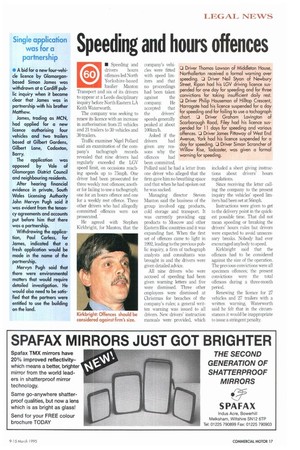Speeding and hours offences
Page 19

If you've noticed an error in this article please click here to report it so we can fix it.
• Speeding and drivers hours offences led North Yorkshire-based haulier Manton Transport and six of its drivers to appear at a Leeds disciplinary inquiry before North Eastern LA Keith Waterworth.
The company was seeking to renew its licence with an increase in authorisation from 21 vehicles and 21 trailers to 30 vehicles and 30 trailers.
Traffic examiner Nigel Pollard said an examination of the company's tachograph records revealed that nine drivers had regularly exceeded the LGV speed limit, on occasions reaching speeds up to 75mph. One driver had been prosecuted for three weekly rest offences; another for failing to use a tachograph; one for an hours offence and one for a weekly rest offence. Three other drivers who had allegedly committed offences were not prosecuted.
He agreed with Stephen Kirkbright, for Manton, that the company's vehicles were fitted with speed limiters and that no proceedings had been taken against the company. He accepted that the drivers' speeds generally peaked at about 1(X)km/h.
Asked if the drivers had given any reasons why the offences had been committed, Pollard said he had a letter from one driver who alleged that the firm gave him no breathing space and that when he had spoken out he was sacked.
Managing director Steven Manton said the business of the group involved egg products, cold storage and transport. It was currently providing egg products to Moscow and other Eastern Bloc countries and it was expanding fast. When the first set of offences came to light in 1992, leading to the previous public inquiry, a firm of tachograph analysts and consultants was brought in and the drivers were given detailed advice.
All nine drivers who were accused of speeding had been given warning letters and five were dismissed. Three other employees were dismissed at Christmas for breaches of the company's rules; a general written warning was issued to all drivers. New drivers' instruction manuals were provided, which
included a sheet giving instructions about drivers' hours regulations.
Since receiving the letter calling the company to the present inquiry the vehicles' speed limiters had been set at 56mph.
Instructions were given to get to the delivery point in the quickest possible time. That did not mean speeding or breaking the drivers' hours rules but drivers were expected to avoid unnecessary breaks. Nobody had ever encouraged anybody to speed.
Kirkbright said that the offences had to be considered against the size of the operation. The previous convictions were all specimen offences; the present convictions were the total offences during a three-month period.
Renewing the licence for 27 vehicles and 27 trailers with a written warning, Waterworth said he felt that in the circumstances it would be inappropriate to issue a stringent penalty.
































































































